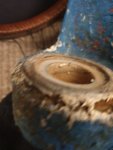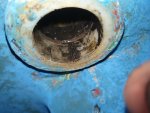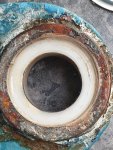sundanceoflorn
New Member
Hoping for some advice after investigating stiff full skeg rudder on my Tyler 34 today. It is more apparent to starboard - from centreline to port seems okay - this is after removing the quadrant and pushing the rudder with one finger.
The helm has been noticeably stiffer last 2 years. I did bottom out when tied to a pontoon and the bottom of the skeg and back of the rudder were on the sea bed as it sloped slightly behind the keel although I am not sure if there was much pressure as it was sand.
There is no obvious sign of cracking or misalignment I can see. I removed the packing from the gland - there were 6 rings black with old grease and 30 years old. The rudder squeaked when moved but I traced that to the fitting in the brass shoe where the bottom of the rudder stock sits. Lifting the rudder up slightly stopped it so I put some grease in and now no squeak. I noted that I could lift the rudder up that way easily except when it was over to starboard. Both these have made some improvement.
I wanted to drop the rudder to see if there are bearings - all I can see is what looks like a nylon bush at the end of the rudder tube where it exits the hull. The problem is that the brass shoe seems to be riveted to the skeg - there are 5 smooth heads either side with no nut or screw head to undo (see photo)
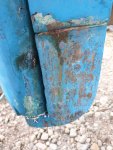
I wondered about removing the packing gland at the top to see if there was access to bearings below but it fits over the fibreglass tube that surrounds the rudder tube and is tight and I didn't want to force it as expect is watertight (see photo).
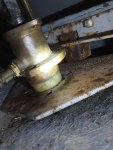
There is hardly any play in the rudder as the bottom shoe fitting is tight fitting and no noise to indicate bearing failure. Any advice on how to proceed or if I am worrying about nothing appreciated
The helm has been noticeably stiffer last 2 years. I did bottom out when tied to a pontoon and the bottom of the skeg and back of the rudder were on the sea bed as it sloped slightly behind the keel although I am not sure if there was much pressure as it was sand.
There is no obvious sign of cracking or misalignment I can see. I removed the packing from the gland - there were 6 rings black with old grease and 30 years old. The rudder squeaked when moved but I traced that to the fitting in the brass shoe where the bottom of the rudder stock sits. Lifting the rudder up slightly stopped it so I put some grease in and now no squeak. I noted that I could lift the rudder up that way easily except when it was over to starboard. Both these have made some improvement.
I wanted to drop the rudder to see if there are bearings - all I can see is what looks like a nylon bush at the end of the rudder tube where it exits the hull. The problem is that the brass shoe seems to be riveted to the skeg - there are 5 smooth heads either side with no nut or screw head to undo (see photo)

I wondered about removing the packing gland at the top to see if there was access to bearings below but it fits over the fibreglass tube that surrounds the rudder tube and is tight and I didn't want to force it as expect is watertight (see photo).

There is hardly any play in the rudder as the bottom shoe fitting is tight fitting and no noise to indicate bearing failure. Any advice on how to proceed or if I am worrying about nothing appreciated

